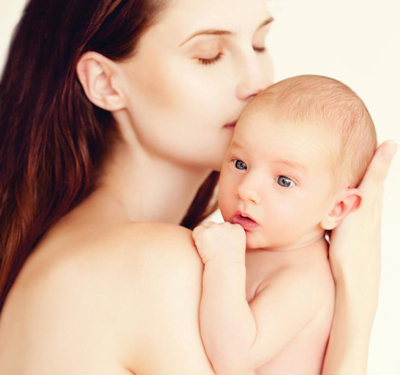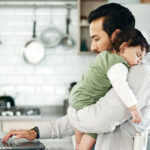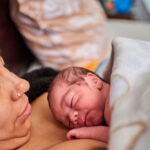Play it safe
Let’s be honest: Parenthood is terrifying. Being responsible for another […]

Security guards
Getting your home ready for its newest occupant is a major factor in providing a safe haven in which your baby can grow and thrive. Here are the high points to consider.
Guard with gates.
Install hardware-mounted safety gates at the top and bottom of all stairways in your home. “Pressure bar gates, which attach to the walls with pressure rather than screws, are suitable for less hazardous [tasks] such as separating rooms,” says safety expert Debra Holtzman, JD, MD, author of The Safe Baby: A Do-It-Yourself Guide to Home Safety and Healthy Living.
Watch for windows.
Install window wedges or stops to prevent windows from being opened more than 4 inches, recommends child safety expert Alison Rhodes, author of Honey, I Lost the Baby in the Produce Aisle: The Safety Mom’s Guide to Childproofing Your Life. If the window opens any farther, your baby could fall through the space.
Curb excess cords.
Opt for cordless window coverings or install cord cleats to tie up blinds’ cords, which can present strangulation hazards, and take special care to keep cords near baby’s crib out of reach.
Prevent furniture falls.
“Secure heavy furniture, paintings and televisions to the walls to prevent them from tipping or falling,” advises Holtzman. Once baby learns to walk, climbing is just around the corner, so take extra precautions around bookcases and other surmountable obstacles.
Stash away breakable bits.
Beloved knickknacks and fragile valuables should be stored out of baby’s reach (for the safety of both baby and the object).
Lock up with latches.
“Drawer and cabinet locks are a must,” notes Rhodes. Be especially cautious with areas such as the kitchen and bathroom that contain sharp, toxic or otherwise dangerous products. Spring for appliance locks for the oven, fridge and toilet.
Soften sharp corners.
Cover furniture edges and fireplaces with corner guards. When baby learns to pull up and walk, those pointed surfaces beg for an encounter with her tiny noggin.
Go crazy for outlet covers.
Every electrical socket in your house should have a protective cover or outlet plug installed.
Check for choking hazards.
Clear your home of any small items that might find their way into baby’s mouth and cause her to choke. (As you might imagine, this will be an ongoing process.) Tip from Holtzman: “If it can fit in an empty toilet paper roll, it isn’t safe [for baby].”
Do doors right.
Install door locks on rooms with hazardous items, and add a dead bolt lock on all exterior doors, suggests Holtzman.
Don’t forget about smoke and carbon monoxide detectors.
“[They] should be installed on every floor of the home and outside every bedroom,” says Rhodes. Batteries should be changed every six months. Also keep fire extinguishers in your home, particularly in areas where a blaze is more likely (i.e., the kitchen).
Welcome to the zoo
If you already have a baby of the four-legged variety, follow these steps to ensure your furry family member gets along with your newborn.
- “Never, under any circumstances, leave a dog alone with your baby. Even the most docile and obedient dog could become aggressive,” notes Rhodes.
- Create a “pets only” and a “babies only” space, so each family member has somewhere to go to escape the other. (Try using baby gates to divide their territories.)
- Introduce baby’s scent before bringing her inside the house, and allow Fido to get to know your newbie while you supervise.
- Teach your little one to play nicely—don’t allow her to tug on your animal’s tail, poke or hit him.
- Make sure your pooch is current on all his shots and checkups, and wash your hands after petting or playing with your pup before handling baby again.
Household how-tos
From the time she wakes up in the morning until the time she goes down for the night, your little one will require constant care and attention. In fact, even everyday activities require preventative measures when an infant is involved.
KITCHEN CARE
Warm with caution. Never heat your baby’s bottle in the microwave. It can cause “hot spots” in the milk, which can scald baby’s sensitive mouth and tongue.
Beat the heat. “Use back burners [while cooking] and keep pot handles turned to the back of the stove,” recommends Holtzman.
Chop it up. Once baby is ready for finger foods, cut her meals into bite-sized pieces no larger than 1/2 inch in any direction.
Remove risks. If your baby can reach it, she can break it or injure herself with it. Avoid placing glassware, sharp or dangerous utensils, and other potential hazards (like hot coffee) within baby’s grasp.
NAPTIME NECESSITIES
Be SIDS safe. Follow the recommended sudden infant death syndrome prevention guidelines: Always put baby on her back to sleep on a firm mattress with a tight-fitting sheet. Avoid loose items in the crib (including stuffed animals, bumpers and blankets) and dress your little one in a breathable garment in which she won’t overheat.
Co-sleep carefully. If you choose to co-sleep, use an approved device that allows baby to share your room from her own separate sleep space.
Create a safe haven. Make sure your child’s crib meets current safety standards (most experts recommend buying new instead of accepting hand-me-downs). Drop-side cribs and cribs with slats more than 2 3⁄8 inches apart are both no-nos.
Monitor cautiously. Don’t keep your baby monitor—or any other item that isn’t made for little hands—inside your child’s crib or within her reach.
BATH BUSTERS
Stay alert always. Scary but true: A baby can drown in less than an inch of water. Never leave your baby unattended during bathtime, even for a second.
Watch water temperature. Your tot’s tub water should be comfortably warm but not hot, somewhere between 90 and 100 degrees.
Get a good grip. Babies are slippery when wet, so add tub grips, a spout cover and a nonskid rug to your registry.
[TIP] Set your water heater to 120 degrees to prevent accidental burns. “Water at a temperature of 140 degrees will produce a third-degree burn on a child in just three seconds,” warns Holtzman.
Awareness on the go
There’s a whole wide world out there to introduce to your brand-new babe. Be safe and have fun as you venture out and explore.
Car caution
“Selecting the right car seat is vital in helping keep your baby safe,” says Rhodes. “Most people don’t realize that car seats actually have expiration dates. The plastic starts to break down after six years [making the seats unsafe].” Also monitor your baby’s weight to be sure she’s within your seat’s recommended guidelines.
Proper installation is equally important. “According to the National Highway Traffic Safety Administration, nearly 80 percent of car seats are installed or used improperly,” Rhodes shares. Before installing your infant’s seat, read the manuals of both your car seat and vehicle, and use the LATCH system if possible (all cars manufactured after September 2002 should be equipped). Once you’ve secured the seat and checked for position accuracy (many models have a lever for easy placement), make sure the fit is tight. You shouldn’t be able to move the seat forward or sideways more than an inch. When you put baby in the seat for a ride, adjust the harness at baby’s shoulders for a snug fit.
Back is best (and not just for sleeping)! Experts recommend keeping your child rear-facing in her car seat until age 2 or until she reaches the maximum height and/or weight limits for your model.
[TIP] The safest place to install a car seat is in the center of the rear seat, or the center of the middle seat in a van or station wagon.
To learn more about car seat safety, visit healthychildren.org; to locate a national child passenger safety technician in your area to help with installation (or check yours for efficiency), visit cert.safekids.org.
Gear guidelines
Whether you’re a stroller or a carrier mom, it’s important to use your equipment correctly. Adhere to all weight standards, and check frequently that baby is safe and sound. When pushing your little one in a buggy, use the brake when you take your hands off the stroller, even if only for a second. Take care to avoid covering your passenger with blankets that she could pull up over her face.
Carriers should also be used with caution. Give your baby plenty of breathing room, and be aware that going “hands-free” doesn’t mean you don’t still need to support your baby. When you bend, squat or lean in any direction, place a hand on your baby for extra support.
Elemental essentials
Headed out in sunny weather? Sun protection is a must. Most pediatricians recommend avoiding both direct sunlight and the use of sunscreen on infants less than 6 months of age—opt for a wide-brim hat or employ that stroller shade!—but protect older babies’ skin with an SPF even on cloudy days. (If your baby is younger than 6 months and sun exposure can’t be avoided, check with your doctor; she’ll likely recommend that a little sunblock will be less damaging than a sunburn and advise you to apply a made-for-baby formula sparingly.)
Be sure to dress your baby appropriately for the weather conditions: cool and comfy in the summer, and warm and cozy in the winter (with plenty of layers for easy adjustments).
Whether you’re at home or away, it’s important to protect your baby from germs and potential sickness. “Babies won’t begin receiving the vaccines that protect them from a host of viruses until the third month,” shares Rhodes. Avoid taking your baby to busy germ-ridden places (such as malls) during cold and flu seasons when possible, and enforce a stringent hand-washing policy for everyone who holds or touches your little one.
First aid facts
In an ideal world, your tot would learn to walk without ever falling down. In reality, however, there are an abundance of boo-boos in your family’s future. Be prepared by brushing up on common treatment techniques.
Bumps and bruises.
After a collision with the coffee table (or any other hard object), apply a cold compress wrapped in a cloth to ease pain and swelling. Keep your baby awake for at least an hour following a head injury to observe any warning signs of something more serious.
Red flags: Inconsolable crying, vomiting, change in pupil size, and trouble focusing are all reasons to dial your doctor or head to the ER.
Scrapes and cuts.
Wash the area with soap and water, pat it dry, and apply an antibiotic ointment and bandage. If the cut is bleeding, apply light pressure to stop the flow before cleaning the area. If a laceration is large or deep, it might require stitches.
Red flags: Watch for heavy bleeding, as well as oozing pus and fever, which could be signs of infection.
Choking and CPR.
Since everything that reaches baby’s hand will likely find its way to her mouth, choking is a major concern for parents. “Anyone who cares for your baby [should] be CPR certified,” recommends Rhodes. While a step-by-step guide to CPR can be helpful, nothing beats the hands-on experience you get from a class, so sign up for one in your area a few months before your due date.
Insect bites and stings.
If a stinger is embedded in your little one’s skin, remove it by scraping it off with a fingernail or credit card. Apply an ice pack to reduce pain and swelling, followed by a paste of baking soda and water to soothe the area and draw out the venom.
Red flags: A severe rash could signal your child is having an allergic reaction; shortness of breath and swelling of the tongue, hands or face also indicate an allergic reaction and necessitate assistance from 911.
Burns.
If your baby accidentally gets burned, immediately place the area under cool running water. If the skin is just red, loosely cover the area with a clean, dry gauze dressing and monitor the burn for infection. Do not apply ice or ointments.
Red flags: Blistered skin warrants a call to the doctor, and severe burns or burns covering large areas of the body require a 911 call.
When in doubt, call your doctor. It’s always better to be safe than sorry!







